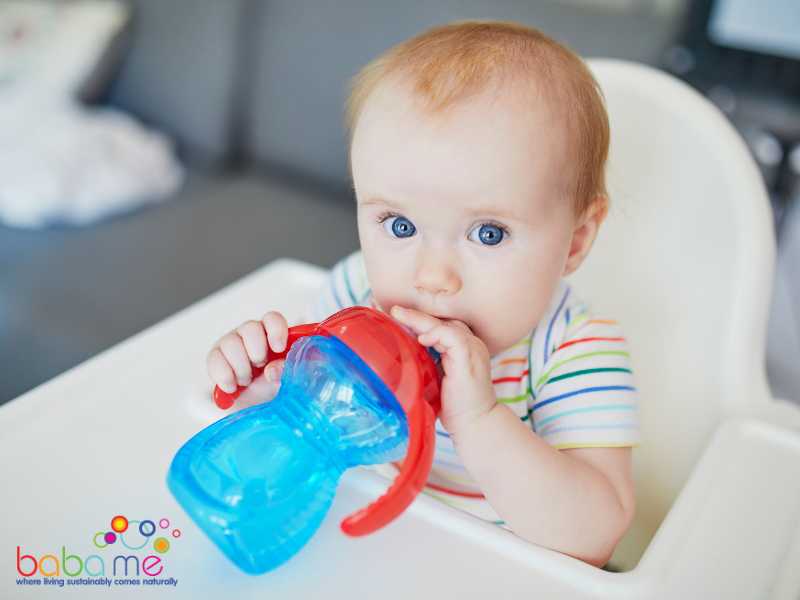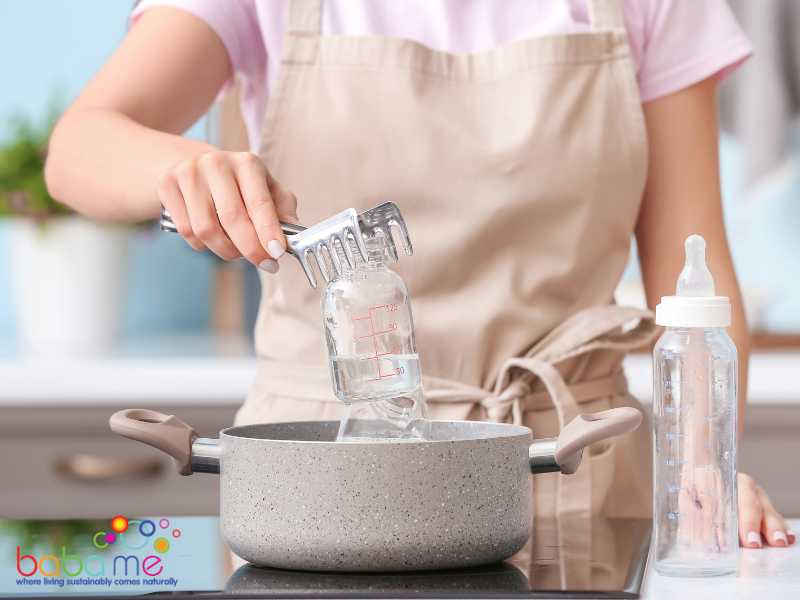Sippy cups: they’re the unsung heroes of transitioning toddlers from bottles to regular cups. Yet, as invaluable as they are, they often hide sneaky residues and can sometimes become the breeding grounds for mold.
With the maze of valves, straws, and handles, cleaning them thoroughly might feel like solving a puzzle.
But don’t fret, this guide will walk you through the steps to ensure a squeaky clean sippy cup, ensuring the health and safety of your little one.
Key Takeaways
Disassemble sippy cups before cleaning to ensure all parts are cleaned thoroughly.
Sterilize sippy cups and parts regularly to kill bacteria and prevent mold growth.
Use natural cleaning alternatives like vinegar and baking soda to avoid harsh chemicals.

Disassembling Sippy Cups
Cleaning sippy cups thoroughly requires disassembling all the small sippy cup parts. Usually, sippy cups have a lid (often with rubber rings), spout, valve, and straw. Before cleaning, you should disassemble the cup completely to remove any leftover residue.
Remove the lid from the cup. Then, remove the spout and valve from the lid. Make sure to inspect the sippy cup valves for any mold or mildew buildup.
If you find any, you can clean it by using a small brush or nipple brush or toothbrush to scrub it thoroughly with hot, soapy water.
Diisassemble the straw from the cup. Some sippy cups have a removable straw, while others have a straw that is attached to the lid. If the straw is removable, you can easily remove it from the lid. If it is attached, you may need to use a small brush to clean it thoroughly.

How to Clean A Sippy Cup
Cleaning sippy cups is an essential part of keeping your little one healthy and safe. Here are some tips to help you clean sippy cups effectively:
Use warm, soapy water to clean all the nooks and crevices of the cup. A bottle brush or straw brush can be helpful in getting into tight spaces.
Rinse the cup thoroughly with hot water to remove any remaining soap residue.
Sterilize the cup and lid using hot water or the microwave. To sterilize with hot water, place the cup and lid in a pot of boiling water for 5 minutes. Alternatively, you can use the microwave by filling the cup with water and microwaving it for 2 minutes. If your cup is dishwasher safe you can just wash in the dishwasher.
For tough stains or odors, try using white vinegar or bleach. Mix one part vinegar or bleach with three parts water, and soak the cup and lid for 30 minutes before rinsing thoroughly and then allow to completely air dry.
After the cups are clean and sterile, wipe them dry using a clean cloth or a tissue and store them in a clean cabinet, away from water or oil.

Sterilizing Sippy Cups
Sterilizing your child’s sippy cup is an important step to ensure that it’s free from harmful germs and bacteria. Here are some methods you can use to sterilize your sippy cups:
Boiling
Boiling is a simple and effective way to sterilize sippy cups. Simply fill a pot with water and place the sippy cup and all its parts, including valves and straws, into the pot. Boil for 5-10 minutes, making sure that all parts are submerged in the water. Once done, remove the sippy cup from the pot and let it cool before use.
Steam Sterilizer
A steam sterilizer is a convenient and efficient way to sterilize sippy cups. Simply place the sippy cup and its parts into the sterilizer and follow the manufacturer’s instructions. The sterilizer will use steam to kill 99.9% of germs and bacteria, leaving your sippy cup clean and safe for your child to use.
Microwave Sterilizer
A microwave sterilizer is another convenient way to sterilize sippy cups. Simply fill the sterilizer with water and place the sippy cup and its parts inside. Microwave for the recommended time, making sure to follow the manufacturer’s instructions. The steam produced by the water will sterilize the sippy cup and its parts.
Bleach Solution
If you prefer a more natural method, you can use a bleach solution to sterilize your sippy cups. Mix one tablespoon of bleach with one gallon of water and soak the sippy cup and its parts in the solution for 2-5 minutes. Rinse thoroughly with water and let it dry before use. Consider using an eco bleach solution which is safer for newborns.
Sanitizing
It’s important to sanitize your sippy cups regularly and keep sippy cups clean to prevent the growth of harmful bacteria. You can use a dishwasher or hand wash the sippy cup with soap and warm water. Make sure to clean all the grooves and crevices thoroughly.
FAQS on How to Sterilize Sippy Cups
How do you clean the inside of a sippy cup?
To clean the inside of a sippy cup, first disassemble all its parts. Use warm soapy water and a bottle brush to scrub the interior of the cup, paying particular attention to any grooves or crevices where residues might hide. Rinse thoroughly with clean water and let the cup air dry completely before reassembling.
Do sippy cups need to be sterilized?
While it’s not strictly necessary to sterilize sippy cups after every use, it’s a good practice to sterilize them occasionally, especially if they’ve been exposed to sickness or if mold has been spotted. Sterilizing eliminates germs and bacteria that regular cleaning might miss, but you don’t need to do this with disposable sippy cups. Just like cleaning high chairs, cleaning baby equipement should be done regularly.
Can you soak sippy cups in vinegar?
Yes, you can soak sippy cups in vinegar to help remove stains, odors, and to naturally disinfect. A mixture of equal parts white vinegar and water works well. After soaking for an hour or so, scrub with a brush, rinse thoroughly, and allow to air dry.
Is it safe to boil my child’s sippy cups?
It depends on the material of the sippy cup. Many sippy cups made of BPA-free plastic can be boiled for sterilization purposes, but always check the manufacturer’s instructions first. Boiling is effective at killing bacteria and other pathogens. If boiling, ensure all parts are fully submerged, and avoid letting them touch the sides or bottom of the pot where they could melt.
How do you get mold out of sippy cup straws?
To clean mold from sippy cup straws, use a small straw brush to scrub the inside. For deep cleaning, soak the straw in a mixture of equal parts white vinegar and water, then use the brush. If mold is persistent, consider replacing the straw.




